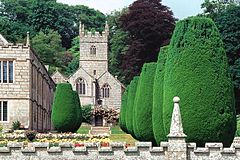
Bodmin is a town and civil parish in Cornwall, England, United Kingdom. It is situated south-west of Bodmin Moor.

St Erth is a civil parish and village in Cornwall, England, United Kingdom.

Lanhydrock House, commonly known simply as Lanhydrock, is a country house and estate in the parish of Lanhydrock, Cornwall, UK.

St Columb Major is a town and civil parish in Cornwall, England, United Kingdom. Often referred to locally as St Columb, it is approximately seven miles (11 km) southwest of Wadebridge and six miles (10 km) east of Newquay The designation Major distinguishes it from the nearby settlement and parish of St Columb Minor on the coast. An electoral ward simply named St Columb exists with a population at the 2011 census of 5,050. The town is named after the 6th-century AD Saint Columba of Cornwall, also known as Columb.
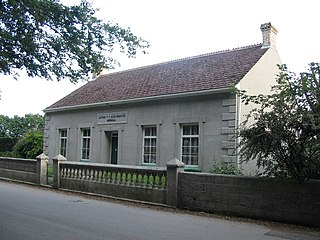
Luxulyan, also spelt Luxullian or Luxulian, is a village and civil parish in mid Cornwall, England, United Kingdom. The village lies four miles (6.5 km) northeast of St Austell and six miles (10 km) south of Bodmin. The population of the parish was 1,371 in the 2001 census. This had risen to 1,381 at the 2011 census.

North Petherwin is a civil parish and village in the historic county of Devon and the ceremonial county of Cornwall, England, United Kingdom. The village is situated five miles (8 km) northwest of Launceston on a ridge above the River Ottery valley.

Advent is a civil parish on the north-western edge of Bodmin Moor in north Cornwall, England, United Kingdom. The English name St Adwenna derives from the Cornish Adhwynn and lies in the Registration District of Camelford.

Egloshayle is a civil parish and village in north Cornwall, England, United Kingdom. The village is beside the River Camel, southeast of Wadebridge. The civil parish stretches southeast from the village and includes Washaway and Sladesbridge.
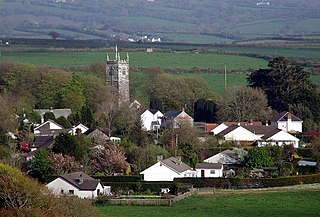
St Tudy is a village and civil parish in north Cornwall, England. The village is situated in the River Camel valley approximately five miles northeast of Wadebridge.

St Issey is a civil parish and village in Cornwall, England, United Kingdom which lies approximately two miles (3 km) south of Padstow. The parish covers an area of approximately 4,500 acres (18 km2). At the 2011 census the parish population was 940. An electoral ward with the name of St Issey also existed before being replaced by St Issey and St Tudy in 2013. Its population at the same census was 4,111.

St Ervan is a rural civil parish and hamlet in Cornwall, England, United Kingdom. The hamlet is situated three miles (5 km) southwest of Padstow. St Ervan is named after St Erbyn, the original patron of the church, who is said to have been the father of St Selevan. Notable features in St Ervan are the Anglican church, the village hall and the Nonconformist cemetery. The parish population at the 2011 census was 521. In addition to the hamlet of St Ervan, also called Churchtown, the parish incorporates the hamlets of Penrose and Rumford.
Feock is a coastal civil parish and village in Cornwall, England, United Kingdom. It is about 5 miles (8.0 km) south of Truro at the head of Carrick Roads on the River Fal. To the south, the parish is bordered by Restronguet Creek and to the east by Carrick Roads and the River Fal. To the north, it is bordered by Kea parish and to the west by Perranarworthal parish.

St Breward is a civil parish and village in Cornwall, England, United Kingdom. It is on the western side of Bodmin Moor, about 6 miles (10 km) north of Bodmin. At the 2011 census the parish population including Cooksland and Fentonadle was 919.

St Endellion is a civil parish and hamlet in north Cornwall, England, United Kingdom. The hamlet and parish church are situated four miles (6.5 km) north of Wadebridge.

Withiel is a civil parish and village in mid Cornwall, England, United Kingdom. The parish of Withiel is between the parishes of St Breock, Lanivet, Roche and St Wenn. The name Withiel comes from the Cornish word Gwydhyel, meaning "wooded place". The parish contains the hamlets of Withielgoose, Retire and Tregawne; the parish had a total population of about 300 in 1824.
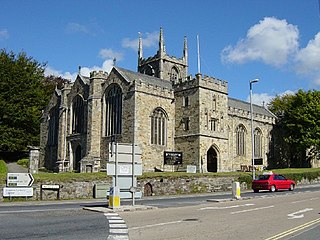
St Petroc's Church, Bodmin, also known as Bodmin Parish Church is an Anglican parish church in the town of Bodmin, Cornwall, England, United Kingdom.

A civil parish is a country subdivision, forming the lowest unit of local government in England. There are 218 civil parishes in the ceremonial county of Cornwall, which includes the Isles of Scilly. The county is effectively parished in its entirety; only the unpopulated Wolf Rock is unparished. At the 2001 census, there were 501,267 people living in the current parishes, accounting for the whole of the county's population. The final unparished areas of mainland Cornwall, around St Austell, were parished on 1 April 2009 to coincide with the structural changes to local government in England.

St Nonna's Church, also known as the Cathedral of the Moors, is the second largest church on Bodmin Moor, Cornwall, located in the village of Altarnun. The dedication is to Saint Non or Nonna, who was the mother of St David. The church is mentioned in Daphne du Maurier's Jamaica Inn; it is the church in which the evil vicar of Altarnun Francis Davey depicts himself in a painting as a wolf while the members of his congregation have the heads of sheep.
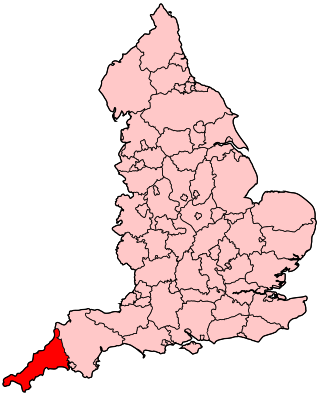
The following outline is provided as an overview of and topical guide to Cornwall: Cornwall – ceremonial county and unitary authority area of England within the United Kingdom. Cornwall is a peninsula bordered to the north and west by the Celtic Sea, to the south by the English Channel, and to the east by the county of Devon, over the River Tamar. Cornwall is also a royal duchy of the United Kingdom. It has an estimated population of half a million and it has its own distinctive history and culture.

St Hydroc's Church, Lanhydrock is a Grade I listed in the Church of England in Lanhydrock, Cornwall.
